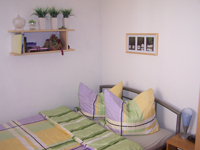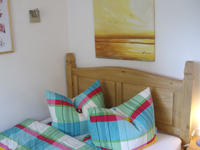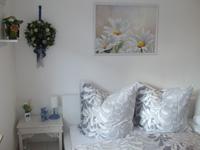Groß St. Martin in cologne
The worth seeing Church of Great St. Martin in Cologne attracts many tourists. But not only their present appearance, but also the long history, which tell their walls, makes them a landmark of the Rheinstadt.

The situation in Cologne
In the middle of Cologne's Old Town, surrounded by a district that was built in the 20th century, the towers of the church tower into the sky. Behind the church, the Rhine meanders through the city. St. Martin was built near its shore. Also not far away is the Cologne Town Hall.
The type Groß St. Martins
Groß Sankt Martin consists of a basilica with two aisles, a nave and a crossing tower. A special hallmark is the clover-shaped altar room with its three apses. In the northern aisle is the crypt, which preserves precious relics. Striking is the decoration of the church, which increases from west to east. Arched friezes with pilaster strips, arched windows with columns, and open gallery supported by columns are striking elements that appear again and again. The structure displays the style of romantic architecture that was common in the period 1150-1250. After many collapses and catastrophes, it had to be rebuilt time and again, so that also components of other eras, for example, from the Baroque, the historicism or the Gothic, intermixed. Especially in the interior, the influence of various contemporary tastes can be seen.


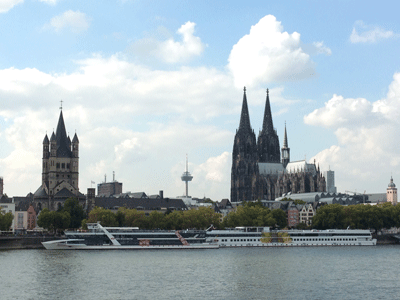
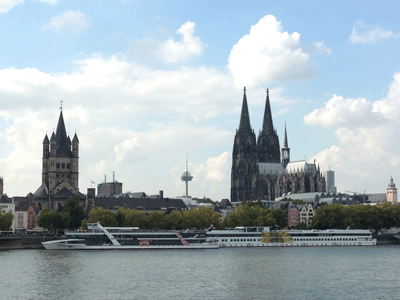
History of the Great St. Martin
Birth of the monastery
Only a few contemporary sources have been preserved from the time of origin of the Church of St. Martin . About the exact historical course can therefore be made only assumptions. It is likely that the name of the church is attributed to Bishop Martin of Tours, whom Catholics worship as saints.
The foundations of the building were laid by the Romans. Excavations prove the thesis of the researchers. Before a church was erected on the banks of the Rhine, a walled area formed the forerunner of today's landmark. Historians suspect that the structure was an arena that served as a sporting activity. A pool of water in the middle of the area could have represented an antique swimming pool. In the 2nd century, people expanded the walls into a covered building. This already had three ships, which were possibly used as warehouses. It is certain that the deceased found their last resting place here. Under the ground were found human remains from that time.
Cologne's old town was then an island, the so-called Rhine suburb, which soon became the commercial center of the settlement. This circumstance supports the assumption of use as warehouses. Trade made the district popular, and soon Emperor Pippin, according to a legend, founded a monastery on the banks of the Rhine. Initially, it was administered by Scottish Benedictines, but xenophobia displaced the immigrants and German monks from the same tribe replaced the original monks. Secularization, ie the takeover of all ecclesiastical institutes, ended the period in the 18th century when Great St. Martin functioned as an abbey.
Destruction and Rebuilding
In 1150, a devastating fire destroyed the church. Only the cloverleaf Trikonchos survived the flames. While the remaining parts of the building had to be rebuilt, this was the only one left unchanged. As faulty constructions repeatedly brought the church to collapse, its façade was constantly changing.
In the 19th century, the former beauty of the building had long since passed. The drama prompted the city of Cologne to invest in a restoration. The Second World War, however, again caused serious devastation. There followed a long debate as to whether it would be worthwhile to once again spend money for a renewed rebuilding Groß St. Martins. Alternatively, it was considered to leave the ruins unchanged as a memorial. Ultimately, they spoke out for the first solution. The newly built church opened in 1985. Five bells are currently ringing for the residents of Cologne and tourists.
Great St. Martin today
In 2007/2008, communities of various origins, including Spaniards and Portuguese, used the former convent to hold religious services. Since 2009, again a religious community has moved to the church. The community of Jerusalem is a group of clergy made up of priests, monks and sisters, but also ordinary believers. They invite people to pray together or lead guests by agreement through the church. Greater St. Martin opens its doors to visitors on all days except Mondays.
Relics and Sights in Groß St. Martin
The foundations of Roman times can still be inspected today. Additional lighting impressively sets them in scene. Even more remarkable is the ceiling painting, which extends over the entire church roof. The painter Alexius Kleinertz made the artwork in the years 1868-1885 at the direction of the architect August Essenwein. The painting depicts the genesis, from the creation of life to the Fall and the subsequent expulsion from the Garden of Eden. In addition, it immortalizes some representatives of the Catholic Church who have carried the faith out into the world.
Many shrines that adorned the church in the past unfortunately fell victim to burglaries and catastrophes. Still preserved are a Holy Cross altar with the Crucifixion group, consisting of the crucified Jesus, the Virgin Mary and the Pope John. An associated sandstone arch is only partially intact. To recognize are only three figures, which probably represent Adam and Eve, as well as a prophet. Another relic shows the funeral of Jesus. A large part of the collection consists of foundations. Historians say that the baptismal font decorated with ornate nets comes from the nearby Brigid Church. In addition to other Jesus representations, Catholic saints such as Ephilius of Rampillon were also given a memorial by a statue. The emperor Pippin, founder of the monastery, was immortalized in this way.
Accommodations close to Gross St. Martin!
Do you want to walk to the church of St. Martin? Then book one of our Fewo Köln, then you can easily reach this church on foot! Just cross the Rhine over the Deutz bridge and stroll through the old town. We look forward to your inquiry!
